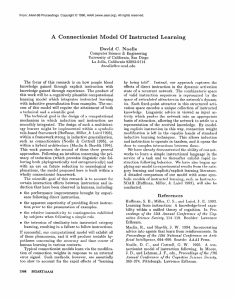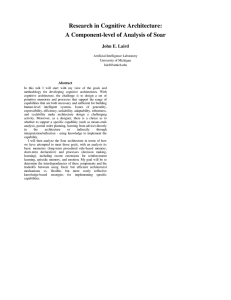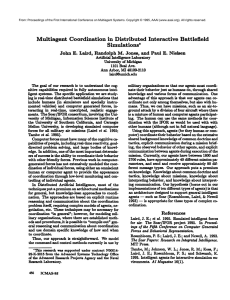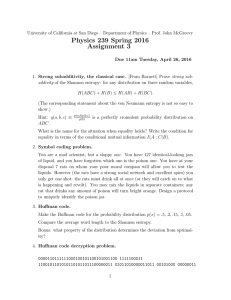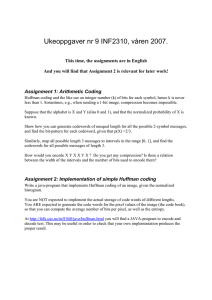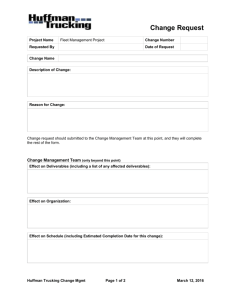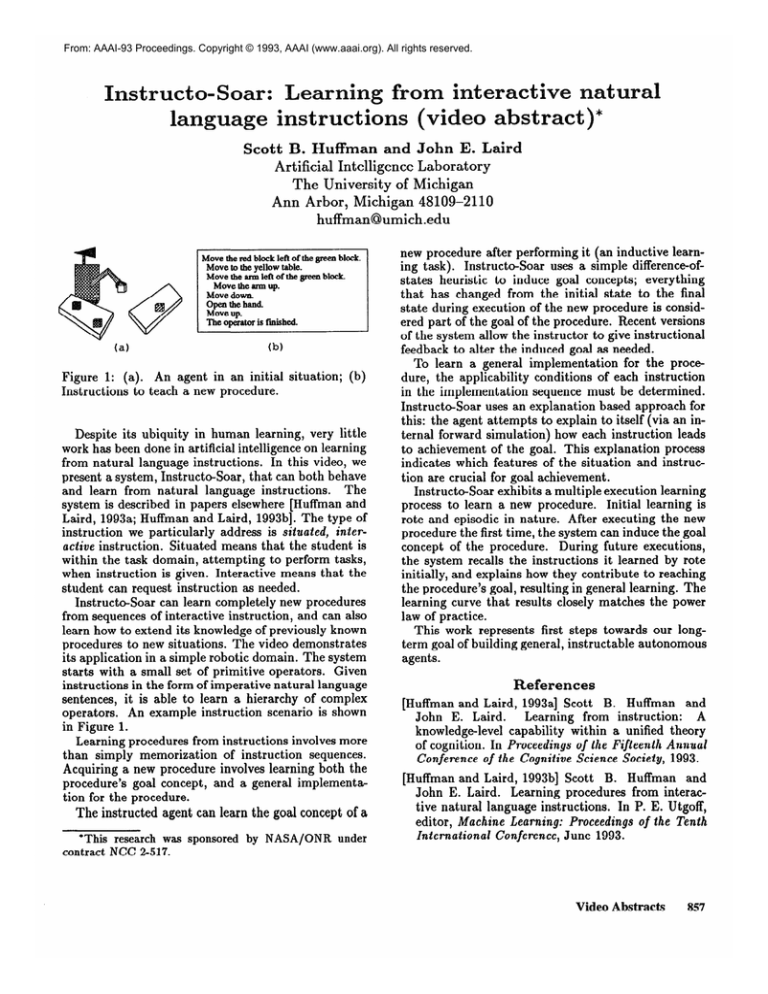
From: AAAI-93 Proceedings. Copyright © 1993, AAAI (www.aaai.org). All rights reserved.
Instructo-Soar:
language
Lea
iinst
Scott B. Huffman and John E. Laird
Artificial Intelligence Laboratory
The University of Michigan
Ann Arbor, Michigan 48109-2110
huffman@umich.edu
Move the red block letk of the green block.
Move to the yellow table.
Move the am letk of the green block.
Move the am up.
Move down
Open the hand.
Move up.
The operator is finished.
(a)
(b)
Figure 1: (a). An agent in an initial situation; (b)
Instructions to teach a new procedure.
1fiapning, very little
Despite its ubiquity in human 1bW1
work has been done in artificial intellig penceon learning
from natural language instructions. In this video, we
present a system, Instructo-Soar, that can both behave
The
and learn from natural language instructions.
system is described in papers elsewhere [Huffman and
Laird, 1993a; Huffman and Laird, 1993b]. The type of
instruction we particularly address is situated, interactive instruction. Situated means that the student is
within the task domain, attempting to perform tasks,
when instruction is given. Interactive means that the
student can request instruction as needed.
Instructo-Soar can learn completely new procedures
from sequences of interactive instruction, and can also
learn how to extend its knowledge of previously known
procedures to new situations. The video. demonstrates
.*
a. . .
.
.
1
.A.,
-1
its applicatron in a simple robotic aomam. 1 ne system
starts with a small set of primitive operators. Given
instructions in the form of imperative natural language
sentences, it is able to learn a hierarchy of complex
operators. An example instruction scenario is shown
in Figure 1.
Learning procedures from instructions involves more
than simply memorization of instruction sequences.
Acquiring a new procedure involves learning both the
procedure’s goal concept, and a general implementation for the procedure.
The instructed agent can learn the goal concept of a
‘This research was sponsored by NASA/ONR
under
new procedure after performing it (an inductive learning task). Instruct&Soar uses a simple difference-ofstates heuristic to induce goal concepts; everything
that has changed from the initial state to the final
state during execution of the new procedure is considered part of the goal of the procedure. Recent versions
of the system allow the instructor to give instructional
feedback to alter the induced goal as needed.
To learn a general implementation for the procedure, the applicability conditions of each instruction
in the implementation sequence must be determined.
Instruct&Soar uses an explanation based approach for
this: the agent attempts to explain to itself (via an internal forward simulation) how each instruction leads
to achievement of the goal. This explanation process
indicates which features of the situation and instruction are crucial for goal achievement.
Instructo-Soar
exhibits a multiple execution
learning
process to learn a new procedure. Initial learning is
rote and episodic in nature. After executing the new
procedure the first time, the system can induce the goal
concept of the procedure. During future executions,
the system recalls the instructions it learned by rote
initially, and explains how they contribute to reaching
the procedure’s goal, resulting in general learning. The
learning curve that results closely matches the power
law of practice.
This work represents first steps towards our longterm goal of building general, instructable autonomous
agents.
References
[Huffman and Laird, 1993a] Scott B. Huffman and
John E. Laird.
Learning from instruction:
A
knowledge-level capability within a unified theory
of cognition. In Proceedings of the Fifteenth Annual
Conference of the Cognitive Science Society, 1993.
[Huffman and Laird, 1993b] Scott B. Huffman and
John E. Laird. Learning procedures from interactive natural language instructions. In P. E. Utgoff,
editor, Machine Learning: Proceedings of the Tenth
International
Conference, June 1993.
contract NCC 2-517.
Video Abstracts
857

